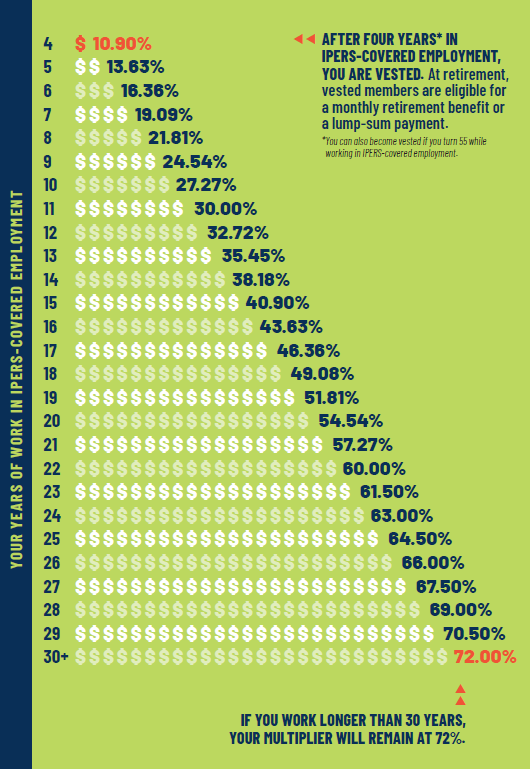Formula

Your IPERS retirement benefit is calculated using this formula:
Your average salary x a multiplier based on the number of years you work in IPERS-covered employment.
Average salary
The salaries used in the calculation are the IPERS-covered wages reported for your over a calendar year (January 1 – December 31). Your average salary is the average of your highest three years’ wages. These don’t have to be the three years that immediately precede your retirement.
Wage spiking
When calculating your average salary, IPERS tests for wage spiking, to prevent overpaying your benefits. Your average salary will be decreased if wage spiking has occurred.
To test your highest three-year average salary for wage spiking, IPERS compares it to a “control-year salary” (your highest calendar year’s salary outside of the three salaries making up your highest three-year average). If your highest three-year average salary is more than 121% of your control-year salary, your salary in the benefit formula will be reduced to 121% of your control-year salary. Additional rules apply when your fourth-highest salary does not represent a full year of salary.
IPERS will review your wages if you stop working before the end of a calendar year. To calculate your wages, we will:
- Look at the wages you earned in each quarter of your last year of employment.
- Look at your highest calendar year wage not used in the highest average salary calculation and calculate the average quarterly wage for that year.
- Use the amount calculated in Step 2 for the quarters you did not work in your last year and add up the amounts for all four quarters. This is called your computed-year wage.
If the computed-year wage is more than your third-highest calendar year wage, then the computed-year wage is used as your final year’s wage. (The computed-year wage is limited to 103% of your highest calendar year wage. This calculation will not result in additional service credit.)

Multiplier
The multiplier increases each year you work in IPERS-covered employment. For Protection Occupations members, the multiplier increases approximately 2.7272% a year for the first 22 years of IPERS-covered work and 1.5% a year for years 23-30. The maximum multiplier is 72%. If you work longer than 30 years, the multiplier remains at 72%.
At retirement, you may “purchase service” — or buy work time — to increase your multiplier.
Computing wages
When calculating your average salary, IPERS tests for wage spiking to prevent overpaying your benefits. Your average salary will be decreased if wage spiking has occurred.
To test your highest three-year average salary for wage spiking, IPERS compares it to a “control-year salary” (your highest calendar year’s salary outside of the three-year average.) If your highest three-year average salary is more than 121% of your control-year salary, your salary in the benefit formula will be reduced to 121% of your control-year salary. Additional rules apply when your fourth-highest salary does not represent a full year of salary.
IPERS will review your wages if you stop working before the end of the calendar year. To calculate your wages, we will:
- Look at the wages you earned in each quarter of your last year of employment.
- Look at your highest calendar year wage not used in the highest average salary calculation and calculate the average quarterly wage for that year.
- Use the amount calculated in step 2 for the quarters you did not work in your last year and add up the amounts for all four quarters. This is called your computed-year wage.
If the computed-year wage is more than your third-highest calendar year wage, then the computed-year wage is used as your final year’s wage. (The computed-year wage is limited to 103% of your highest calendar year wage. This calculation will not result in additional service credits.)
Early retirement
If all your IPERS-covered jobs are considered Special Service, you benefit is not reduced for early retirement. If you work in a Regular IPERS-covered position at any point in your career, a hybrid formula may be used to calculate your benefit, in which case your benefit may be reduced for early retirement.